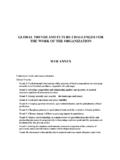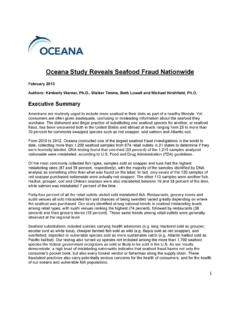Transcription of 2. Change in the livestock sector
1 livestock IN THE BALANCE92. Change in the livestock sectorConsumption trends and drivers1 trends in consumptionConsumption of livestock products has increased rapidly in developing countries over the past decades, particularly from the 1980s onwards. Growth in consumption of livestock products per capita has markedly outpaced growth in consumption of other major food commodity groups (Figure 1). Since the early 1960s, consumption of milk per capita in the developing countries has almost doubled, meat consumption more than tripled and egg consumption increased by a factor of More detailed information about the most recent trends in consumption, production and trade, by country, can be found in the Statistical annex at the end of this report.
2 The analysis and data presented in this and the following sections cover consumption, production and trade of livestock products. Animal-source food of other origins such as fish and bushmeat are not growth and technological innovation have led to profound structural changes in the livestock sector , including: a move from smallholder mixed farms towards large-scale specialized industrial production systems; a shift in the geographic locus of demand and supply to the developing world; and an increasing emphasis on global sourcing and marketing.
3 These changes have implications for the ability of the livestock sector to expand production sustainably in ways that promote food security, poverty reduction and public health. This chapter reviews trends in and the outlook for consumption, production and trade of livestock products and accompanying technological and structural changes in the sector . It discusses the structure and diversity of the livestock sector and factors that will shape the sector over the coming decades. Challenges facing efforts to improve livelihoods, alleviate poverty and food insecurity, reduce pressures on natural resources and manage human and animal diseases are 1 Per capita consumption of major food items in developing countries, 1961 2005 Source.
4 FAO, 63 65 67 69 71 73 75 77 79 81 83 85 87 89 91 93 95 97 99 01 03 05 MilkCerealsEggs Meat Roots and tubersIndex (1961 = 100)THE STATE OF FOOD AND AGRICULTURE 200910 This has translated into considerable growth in global per capita intake of energy derived from livestock products, but with significant regional differences (Figure 2). Consumption has increased in all regions except sub-Saharan Africa. Also, the former centrally planned economies of Eastern Europe and Central Asia saw major declines around 1990.
5 The greatest increases have occurred in East and Southeast Asia and in Latin America and the 1 summarizes per capita consumption of meat, milk and eggs for the major developed- and developing-country groups since 1980. The most substantial growth in per capita consumption of livestock products has occurred in East and Southeast Asia. China, in particular, has seen per capita consumption of meat quadruple, consumption of milk increase tenfold, and egg consumption increase eightfold. Per capita consumption of livestock products in the rest of East and Southeast Asia has also grown significantly, particularly in the Democratic People s Republic of Korea, Malaysia and Viet too has experienced a rapid expansion in the consumption of livestock products per capita consumption of meat has almost doubled, while that of milk has increased by 40 percent.
6 In the rest of Latin America and the Caribbean, increases in consumption have been more modest, with some exceptions. The Near East and North Africa has seen a 50 percent increase in consumption of meat and a 70 percent increase in egg consumption, although milk consumption has declined slightly. In South Asia, including India, per capita consumption of livestock products has grown steadily, although meat consumption remains low. Among the developing-country regions, only sub-Saharan Africa has seen a modest decline in per capita consumption of both meat and the developed countries overall, growth in per capita consumption of livestock products has been much more modest.
7 The former centrally planned economies of Eastern Europe and Central Asia suffered a sudden drop in per capita consumption of livestock products in the early 1990s and consumption has not recovered since as a result, per capita meat consumption in 2005 was 20 percent below its 1980 of livestock products per capita in developing regions is still 3002001000400600700800500 FIGURE 2 Per capita intake of energy derived from livestock products by region, 1961 2005 Source: FAO, : livestock products include meat, eggs and milk and dairy products (excluding butter).
8 61 63 65 67 69 71 73 75 77 79 81 83 85 87 89 91 93 95 97 99 01 03 05 East and Southeast AsiaLatin America and the CaribbeanNear East and North AfricaFormer centrally planned economiesOther developed countriesSouth AsiaSub-Saharan Africakcal/person/dayLIVESTOCK IN THE BALANCE11substantially lower than in the developed world, even though some rapidly developing countries are narrowing the gap (Table 1). There is significant potential for increasing per capita consumption of livestock products in many developing countries.
9 The extent to which this potential will translate into increasing demand depends on future income growth and its distribution among countries and regions. Rising incomes are more likely to generate additional demand for livestock products in low-income countries than in middle- and high-income of consumption growthThe growing demand for livestock products in a number of developing countries has been driven by economic growth, rising per capita incomes and urbanization. In recent decades, the global economy has experienced an unparalleled expansion, with per capita incomes rising rapidly.
10 The relationship between per capita income and meat consumption for 2005 is illustrated in Figure 3. The figure shows a strongly positive effect of increased incomes on livestock consumption at lower income levels but a less positive, or even negative, effect at high levels of GDP per factors also underlie changing consumption patterns of livestock products. An important factor has been urbanization. The share of total population living in urban areas is larger in the developed countries than in developing countries (73 percent compared with an average of 42 percent).
















